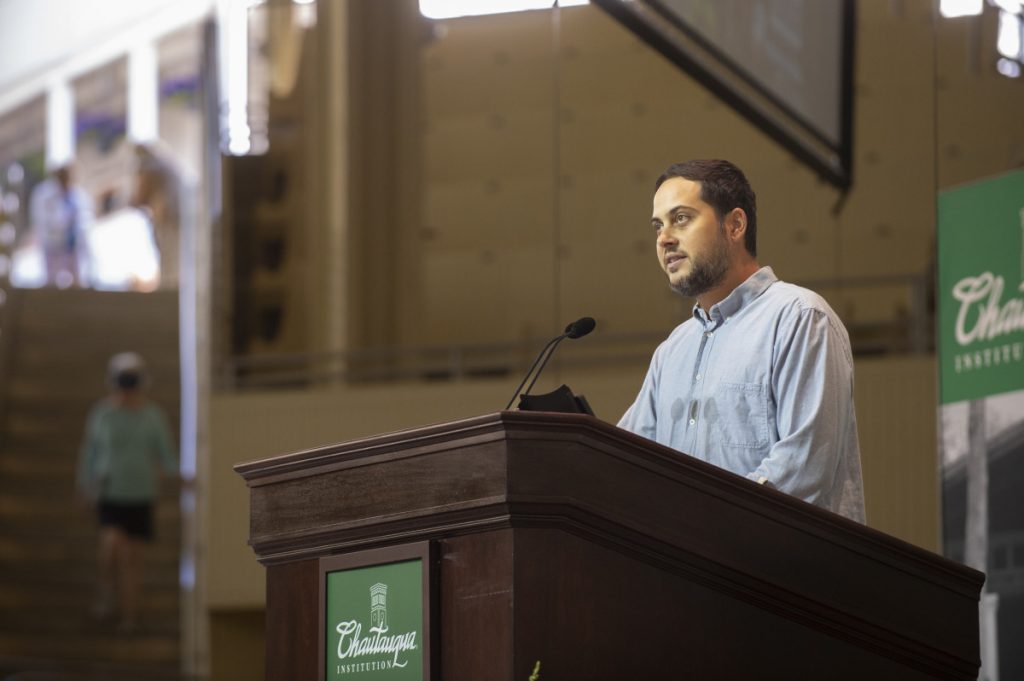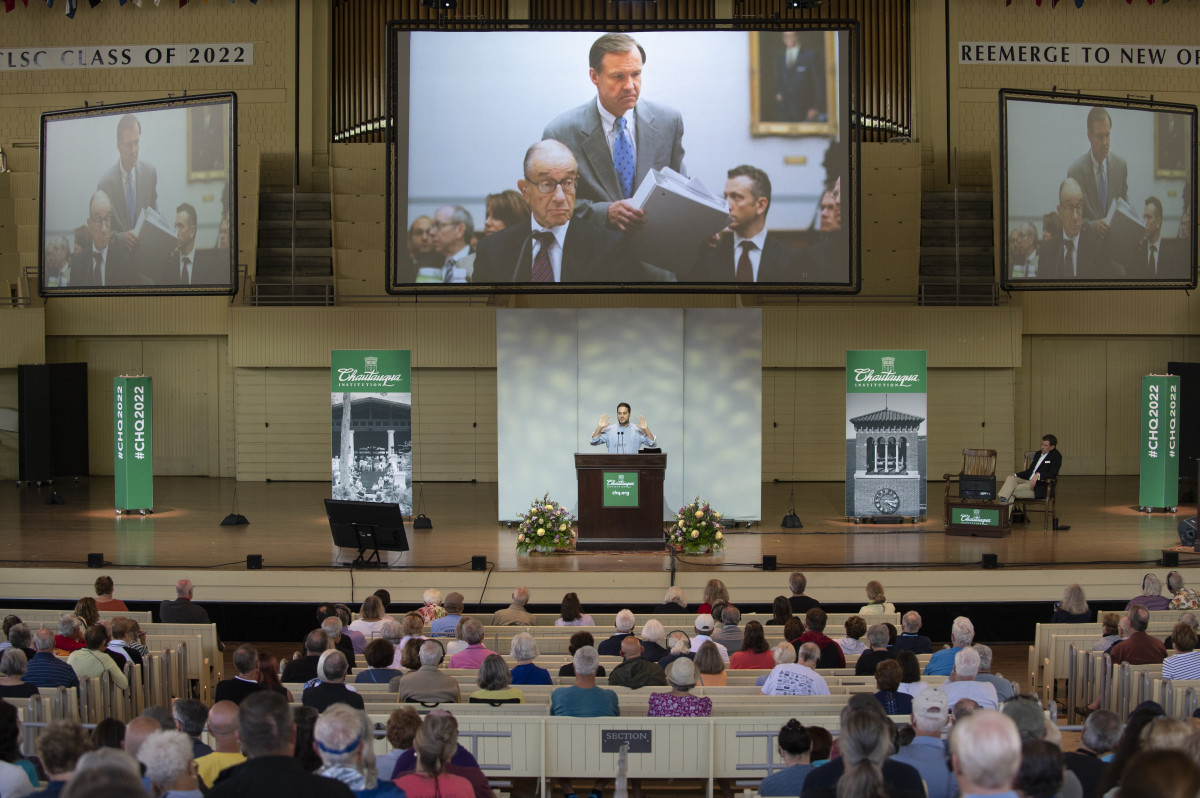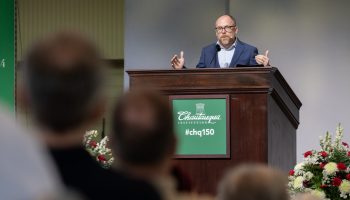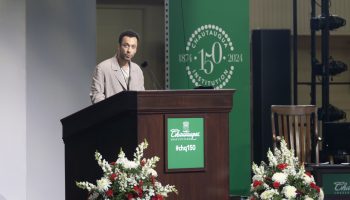Filmmaker Giorgio Angelini addressed three seemingly disparate phenomena in his documentary “Owned: A Tale of Two Americas.”
He broached the housing explosion in the desert region of California. He also looked at the killing of Freddie Gray by police in 2015, and finally at an American mortgage system that has placed Black people at a disadvantage.
Then, he linked them all together.
“To fix one problem, we have to fix another,” Angelini told the audience at his 10:45 a.m. lecture Thursday in the Amphitheater, titled “The Anti-Social Contract: Rethinking Our Home Ownership Society,” part of the Chautauqua Lecture Series Week Seven theme, “More than Shelter: Redefining the American Home.”

Angelini has a master’s in architecture from Rice University. After earning his master’s, he opened a boutique architecture firm, Schaum/Shieh Architects, with his former professor. Angelini’s experience of working on housing-related issues led to his exploration of film. “Owned” premiered on PBS spring 2022.
Angelini’s film and lecture argued the “tear it all down” dynamic witnessed in Baltimore and Ferguson, Missouri, occurs when people lose control of their communities, and subsequently, their sense of place.
Outside corporate and government entities decide whether someone owns a home, and under what conditions they own it. Historically, in the post-World War II era and beginning with suburban boomtowns like Levittown, New York, that meant excluding underrepresented populations to the benefit of the mortgage-endowed white middle class. It meant leaving the populations that remained — largely Black, inner-city populations — to shoulder the fallout from a mass exodus of people and resources.
Levittown is often used as the model of post-World War II suburban development. The massive development was the brainchild of builder William Levitt, who Angelini said “turned the war machine into a home-building machine.” Levitt could build a home in as little as one week, aided by cheap construction materials and the Federal Housing Administration, which helped create a post-war housing boom in communities like Levitt’s by ensuring home mortgages.
But the FHA also created the practice of redlining, which is identifying neighborhoods viewed as too risky for mortgage investment and insuring.
Angelini turns his lens to a sinister aspect of Levittown: its exclusion of Black people as homeowners. In Angelini’s film, a woman in circa-1950s black-and-white footage says: “We understood it would be all-white, and we were happy to buy a home here.”
In Angelini’s exploration of Levittown, a retired Nassau County police officer, Jimmy Silvestri, serves as a sort of narrator. After World War II, Silvestri’s family moved from the Bedford-Stuyvesant borough of New York to the former potato farms that became Levittown. Silvestri raised his family in the same house he grew up in. For Silvestri, Angelini said, Levittown is a utopia.
But Silvestri acknowledges there is an unseemly side, with Levittown’s outright racism. “That is disgraceful,” Silvestri lamented, also acknowledging the favor families like his experienced from a rigged system.
“When you look at our history, particularly since World War II when the U.S. government embarked on this radical reordering of society, subsidizing both the construction and ownership of the single-family home,” Angelini said, “this enormous social engineering project also meant racially segregating cities and depriving minority communities of opportunity while pouring money into suburbs, when you take into account the persistent and destructive boom-and-bust real estate cycles that only seem to intensify wealth inequality, when you begin to realize that the only reasonable definition of the American Dream today is as a cruel fantasy.”
To demonstrate the long-term effects of redlining, Angelini referred to the social mobility studies of Harvard University researcher Raj Chetty; his studies show that the single biggest predictor of one’s ability to advance socioeconomically is one’s zip code.
“Pulling yourself up by your bootstraps is simply no match for place,” Angelini said.
The conditions on the east side of Baltimore, where Freddie Gray lived, were poor.
“(Children growing up on the east side) were the unlucky ones born into the wrong zip code because of decades of discriminatory housing policy that had placed them there,” Angelini said. “To diminish a kid’s capacity to dream by forcing them into a kind of urban incarceration is about the cruelest thing I can imagine.”
In his film’s narrative on the need to redefine the American home, Angelini turned to the Inland Empire of Southern California. Much of the Inland Empire — the largest geographic county in the U.S. at 27,000 square miles — is desert. The area prospered as part of the Southern California “Citrus Belt” around the turn of the 20th century, with orange groves dominating the landscape. But by mid-century, the groves were being bulldozed to accommodate urban sprawl.
Today little in the way of orange groves remains.
“They (razed) orange groves to make way for the new commodity … to be sold on the international market: air-conditioned square footage,” Angelini said.
To compound matters, only 30% of those in the Inland Empire can afford a median-priced home. Across the United States, Angelini said, median income wage earners can’t afford homes in 70% of the country. And for one-quarter of home sales, private investors and hedge funds are offering cash, terms with which the average prospective homeowner cannot compete.
“A housing implosion in the middle of the desert in California (is) inextricably linked to the death of Freddie Gray,” Angelini said. “(These) were two sides of the same coin, two sides of the American home, and to fix one problem, we really (have) to fix the other.”
He drew on the story of Greg, a once-hopeful young Black man in Baltimore who drove a pocket knife into a fire hose during the Baltimore uprisings. These images circulated on national television.
“What Greg was trying to say, through his kinetic action, was that there was no system worth saving here,” Angelini said. “Why not burn it all down? And the truth is when you understand the history, how can you really argue with that? Why would any reasonable person want to preserve such an inhuman system specifically designed to keep people like Greg down?”
A core problem is viewing homes primarily as investments, as commodities, Angelini said. Architecture was “having too much fun building totems to capitalism” in the late 2000s, Angelini said. He said the housing crash of the late 2000s proved “profit-driven self-interest was not a way of being a (free) society.”
“Our housing economy is one predominantly driven, legislated and controlled by profit-motivated forces,” Angelini said. “Those narrow interests are allowed to dictate critical decisions around housing policy, around urban planning and infrastructure investments, about the very social fabric of our society, hoping that the profits might also produce the right social outcomes as a convenient byproduct.”
He paraphrased an observation of a Southern California realtor, Jim, who appears prominently in “Owned.”
“It’s always been a problem in this industry that there is only one way to determine what something is worth (and that is) to look at what other people have paid for it,” Angelini said. “But what if the other people are crazy? I guess what I’m here to tell you is I think we’re all crazy. I think we’re all crazy. The American home economy of today has deluded us into believing that we’re living in times of great scarcity. It’s helped to transform this country into an increasingly anxious, self-centered and paranoid place. It’s made us crazy.”
He closed with a challenge to the audience to begin by acknowledging the problem.
“Do we radically change the American home in such a way that we account for its racist legacy and build a future that makes us less alienated from one another, less anxious and more secure?” he asked.
Following the lecture, Angelini participated in a Meet the Filmmaker Q-and-A after a screening of “Owned: A Tale of Two Americas” at the Chautauqua Cinema.





